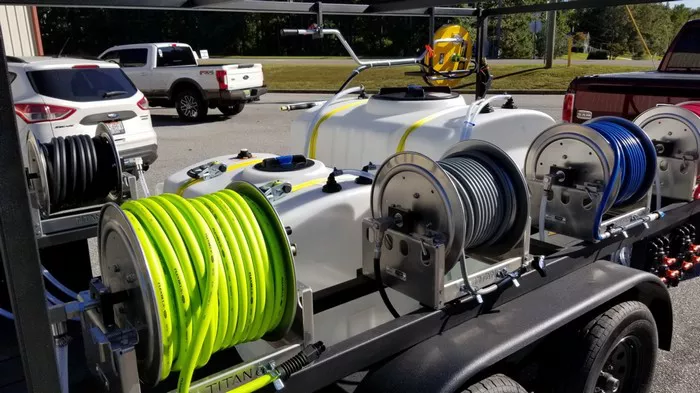Pressure washer pumps are the heart of any pressure washing system, responsible for generating the high-pressure water needed to tackle tough cleaning tasks. Without a properly functioning pump, a pressure washer loses its effectiveness and efficiency. Understanding the importance of maintaining your pressure washer pump, including using the right type of oil, is crucial for ensuring its longevity and optimal performance.
Importance of Oil in Pressure Washer Pumps:
Oil plays a critical role in the performance and longevity of pressure washer pumps. It serves as a lubricant, reducing friction between the pump’s internal components as they operate under high pressure and speed. Proper lubrication is essential for preventing premature wear and tear, minimizing heat buildup, and ensuring smooth operation.
Using the correct oil for your pressure washer pump is paramount. The right oil not only lubricates the pump effectively but also helps maintain its seals and gaskets, preventing leaks and extending the pump’s lifespan. Neglecting proper oil maintenance can lead to pump failure, costly repairs, and downtime.
Types of Oil for Pressure Washer Pumps:
1. Non-detergent SAE 30 oil: Non-detergent SAE 30 oil is a commonly recommended oil for pressure washer pumps. Its viscosity and lubricating properties make it suitable for most pump models, providing adequate protection against wear and corrosion. This type of oil is readily available and cost-effective, making it a popular choice among pressure washer users.
2. Synthetic oil: Synthetic oil offers several advantages over conventional oils, especially in extreme operating conditions. Its synthetic formulation provides superior lubrication, reducing friction and heat buildup even in high-temperature environments. Synthetic oil also resists oxidation and degradation better than traditional oils, resulting in longer oil life and improved pump performance.
3. Manufacturer-recommended oil: Many pressure washer manufacturers specify the type of oil recommended for their pumps. It’s crucial to follow these guidelines to ensure optimal performance and warranty compliance. Using the manufacturer-recommended oil helps maintain the pump’s integrity and prevents compatibility issues that may arise with other oil types.
How to Check and Change the Oil:
Regularly checking and changing the oil in your pressure washer pump is essential for its proper maintenance. Here’s a step-by-step guide on how to do it:
1. Check the oil level: Before starting the pressure washer, ensure the oil level is within the recommended range. Locate the oil dipstick or sight glass on the pump and remove it to inspect the oil level. Add oil if necessary to maintain the correct level.
2. Drain the old oil: If the oil is dirty or discolored, it’s time for a change. To drain the old oil, place a drain pan beneath the pump and remove the drain plug or bolt. Allow the oil to drain completely before proceeding.
3. Refill with fresh oil: Once the old oil has drained, replace the drain plug and refill the pump with fresh oil of the appropriate type and viscosity. Use a funnel to prevent spills and overfilling.
4. Check for leaks: After refilling the oil, check for any signs of leaks around the pump. Tighten fittings or replace seals as needed to prevent oil leaks.
5. Dispose of old oil properly: Dispose of the old oil according to local regulations. Many auto parts stores or recycling centers accept used oil for proper disposal.
Tips for Maintaining Pressure Washer Pumps:
In addition to regular oil changes, here are some tips for maintaining your pressure washer pump:
1. Inspect seals and fittings: Periodically check the pump’s seals and fittings for signs of wear or leaks. Replace any damaged seals or tighten loose fittings to prevent leaks and maintain pressure.
2. Flush the pump: After each use, flush the pump with clean water to remove any debris or detergent residue. This helps prevent clogs and prolongs the pump’s life by keeping it clean and free from buildup.
3. Store properly: When not in use, store the pressure washer in a dry, sheltered location away from the elements. This helps prevent rust and corrosion, prolonging the pump’s lifespan and maintaining its performance.
Common Mistakes to Avoid:
Despite the importance of proper oil maintenance, users often make common mistakes that can compromise their pressure washer pumps’ performance and longevity. Here are some pitfalls to avoid:
1. Using the wrong type of oil: Using the incorrect oil viscosity or formulation can lead to inadequate lubrication and pump damage. Always use the type of oil recommended by the manufacturer for your specific pressure washer model.
2. Neglecting regular maintenance: Skipping oil changes or neglecting other routine maintenance tasks can result in pump failure and costly repairs. Make sure to follow the manufacturer’s maintenance schedule and guidelines to keep your pressure washer in top condition.
3. Ignoring leaks or unusual noises: Leaks or strange noises coming from the pump are signs of potential problems that should not be ignored. Addressing these issues promptly can prevent further damage and prolong the pump’s lifespan.
Conclusion:
Proper maintenance of your pressure washer pump, including using the correct type of oil and following recommended guidelines, is essential for ensuring its longevity and optimal performance. By understanding the role of oil in lubricating the pump’s internal components and following best practices for oil maintenance, you can prevent costly repairs and downtime, allowing you to tackle tough cleaning tasks with confidence.
Remember to check the oil level regularly, change the oil as needed, and follow the manufacturer’s recommendations for oil type and viscosity. By prioritizing proper maintenance, you can extend the life of your pressure washer pump and keep it running smoothly for years to come.

